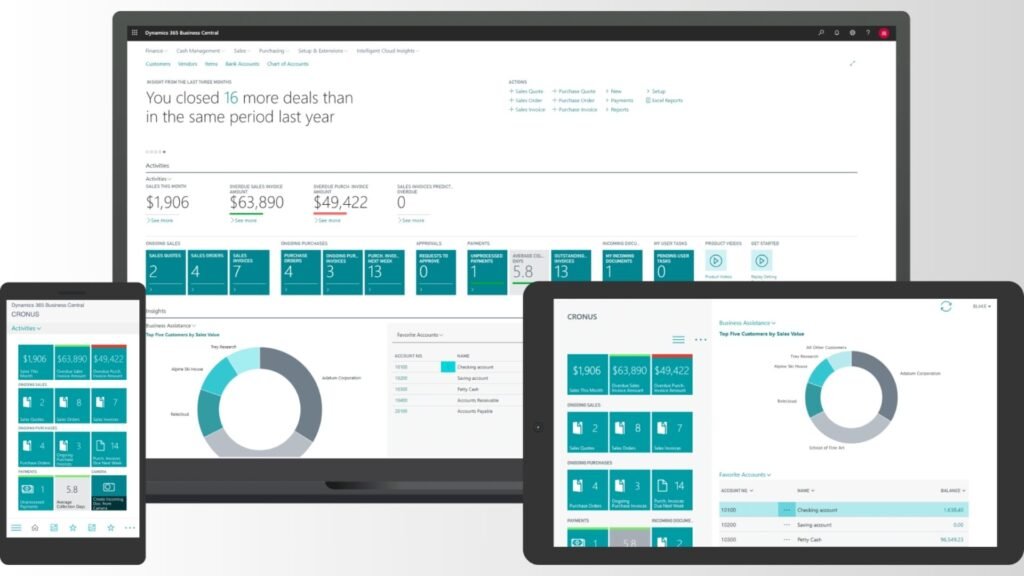When it comes to digital transformation, businesses in the United States are increasingly investing in ERP (Enterprise Resource Planning) solutions to streamline operations, improve decision-making, and drive growth. Among Microsoft’s robust ERP offerings, two solutions stand out—Dynamics 365 Business Central and Dynamics 365 Finance & Operations (F&O).
Choosing between these two platforms can be challenging. Both are powerful, cloud-based solutions designed to unify business processes, but they cater to different organizational sizes, industries, and complexities. To make the right choice, businesses must evaluate their goals, processes, and future scalability.
This article provides a detailed comparison of Business Central and Finance & Operations, highlights their features, and explains how working with a trusted Microsoft Dynamics 365 partner in USA can help businesses successfully implement the right ERP solution.
Why ERP Choice Matters for U.S. Businesses
The right ERP is not just a technology investment—it’s a strategic decision that shapes how a business operates. A poorly chosen ERP can lead to inefficiencies, wasted investments, and employee frustration. On the other hand, selecting the right solution with expert ERP implementation services in USA ensures long-term scalability, compliance, and competitive advantage.
Overview: Dynamics 365 Business Central
Business Central is Microsoft’s ERP designed primarily for small to mid-sized businesses (SMBs). It evolved from Dynamics NAV and offers a streamlined, all-in-one solution that covers core business processes.
Key Features of Business Central
- Financial Management – General ledger, accounts payable/receivable, cash flow, and budgeting.
- Supply Chain Management – Inventory tracking, purchasing, and vendor management.
- Project Management – Job costing, time tracking, and resource allocation.
- Sales & Customer Service – Quote-to-cash processes and CRM integration.
- Integration with Microsoft 365 – Seamlessly works with Outlook, Excel, Teams, and Power BI.
Ideal for:
- Growing SMBs with 50–500 employees.
- Companies that want a cost-effective yet powerful ERP.
- Businesses upgrading from QuickBooks, GP, or NAV.
Overview: Dynamics 365 Finance & Operations
Finance & Operations (F&O), also known as Dynamics 365 Finance and Dynamics 365 Supply Chain Management, is built for large enterprises and global organizations with complex operations.
Key Features of Finance & Operations
- Advanced Financial Management – Multi-currency, multi-company, global tax compliance, and advanced reporting.
- Supply Chain Management – End-to-end visibility across production, warehousing, and distribution.
- Manufacturing & Production Planning – Lean, discrete, and process manufacturing support.
- Human Resources & Workforce Management – Payroll integration and talent management.
- AI and Predictive Insights – Real-time analytics for forecasting and strategic planning.
Ideal for:
- Enterprises with more than 1,000 employees.
- Multinational corporations with global operations.
- Complex industries like manufacturing, retail, finance, and logistics.
Business Central vs. Finance & Operations: A Feature Comparison
| Feature | Business Central | Finance & Operations |
|---|---|---|
| Target Audience | SMBs and mid-sized companies | Large enterprises & multinational corporations |
| Deployment | Cloud-first (with some hybrid options) | Cloud (Azure) |
| Financials | Strong, but focused on SMB needs | Advanced financials with multi-company, global compliance |
| Supply Chain | Inventory & basic warehouse management | Advanced supply chain with manufacturing, logistics, IoT integration |
| Scalability | Suitable for mid-market growth | Enterprise-level scalability |
| Cost | Lower licensing and implementation cost | Higher cost, but more advanced capabilities |
| Implementation Timeline | 2–6 months (faster rollout) | 6–18 months (complex rollout) |
| Customization | Flexible, but lighter compared to F&O | Highly customizable for large enterprises |
| Integration | Microsoft 365, Power Platform | Microsoft 365, Power Platform, Azure AI, IoT |
Key Considerations When Choosing Between Business Central and Finance & Operations
1. Company Size & Complexity
- If your business is small or mid-sized with relatively simple processes, Business Central is a great fit.
- If you’re managing multiple subsidiaries, global supply chains, and complex manufacturing, F&O is the right choice.
2. Budget & Total Cost of Ownership (TCO)
- Business Central has lower licensing and faster implementation, making it more cost-effective for SMBs.
- F&O requires larger investment but delivers advanced functionality suited for enterprises.
3. Industry Requirements
- Businesses in retail, professional services, and distribution often prefer Business Central.
- Industries like manufacturing, logistics, and finance with global operations typically choose F&O.
4. Growth Plans
- If you expect steady growth within the mid-market range, Business Central scales well.
- If rapid expansion and international operations are on the horizon, F&O provides enterprise scalability.
Role of a Microsoft Dynamics 365 Partner in USA
Choosing between Business Central and Finance & Operations is only the first step. To ensure a successful ERP journey, businesses need the expertise of a certified Microsoft Dynamics 365 partner in USA.
How a Partner Helps:
- Business Assessment: Evaluate current systems and recommend the best-fit ERP.
- ERP Implementation Services in USA: Deliver end-to-end deployment with minimal disruption.
- Customization & Integration: Adapt Dynamics 365 to unique business processes.
- Training & Adoption: Ensure employees adopt ERP effectively.
- Ongoing Support: Provide continuous updates, monitoring, and managed services.
Working with an experienced partner reduces risk, ensures faster ROI, and aligns ERP investments with business goals.
Microsoft Dynamics 365 Implementation in USA: What to Expect
Whether you choose Business Central or Finance & Operations, the implementation journey is critical. Here’s what U.S. businesses can expect from professional Microsoft Dynamics 365 implementation in USA:
- Discovery & Planning – Understanding business requirements, processes, and goals.
- System Design – Configuring Business Central or F&O to fit your workflows.
- Data Migration – Secure transfer of historical data from legacy systems.
- Testing & Training – Ensuring employees can use the system confidently.
- Go-Live & Support – Smooth transition with minimal downtime.
- Continuous Improvement – Leveraging updates, AI, and analytics for optimization.
This structured approach ensures businesses not only implement ERP but also maximize its value.
Microsoft Dynamics Services in USA: Beyond Implementation
ERP is not a one-time project; it’s an ongoing journey. That’s why companies need long-term Microsoft Dynamics services in USA to support their ERP ecosystem.
Key Services Include:
- Upgrade & Migration Services – Moving from NAV, GP, or AX to Dynamics 365.
- Customization & App Development – Tailoring ERP to industry needs.
- Integration Services – Connecting ERP with CRM, HR, POS, or third-party apps.
- ERP Support & Managed Services – Proactive monitoring and issue resolution.
- Analytics & Reporting – Leveraging Power BI for data-driven decisions.
Partnering with experts ensures ERP evolves with your business, rather than becoming outdated.
Real-World Example
A mid-sized distribution company in Texas was struggling with QuickBooks and manual inventory tracking. They partnered with a Microsoft Dynamics 365 partner in USA and migrated to Business Central.
- Result: Improved inventory accuracy by 40%, reduced financial closing time by 50%, and gained real-time reporting.
Meanwhile, a global automotive manufacturer in Michigan needed a system to handle complex supply chains across multiple continents. By implementing Dynamics 365 Finance & Operations:
- Result: Achieved end-to-end supply chain visibility, compliance with international tax regulations, and improved production efficiency by 25%.
This comparison illustrates how Business Central and F&O serve different organizational needs.
Benefits of Choosing the Right ERP with Expert Support
- Cost Optimization – Right-sized ERP prevents overspending.
- Compliance & Security – Meet U.S. regulations and industry standards.
- Increased Productivity – Automation reduces manual work.
- Scalability – ERP grows with your business.
- Faster ROI – Expert ERP implementation services in USA ensure a quicker return on investment.
Conclusion
Both Dynamics 365 Business Central and Dynamics 365 Finance & Operations are powerful ERP platforms—but they serve different needs. Business Central is best suited for small to mid-sized businesses seeking affordability and simplicity, while Finance & Operations is built for large enterprises with complex, global operations.
To make the right choice, businesses must carefully evaluate size, industry requirements, and growth plans. Most importantly, partnering with an experienced Microsoft Dynamics 365 partner in USA ensures a smooth implementation and long-term ERP success.
With the right guidance, Microsoft Dynamics 365 implementation in USA delivers not only streamlined operations but also strategic advantages that fuel business growth. Supported by expert Microsoft Dynamics services in USA and ERP implementation services in USA, companies can future-proof their operations and stay ahead in an increasingly competitive market.
Frequently Asked Questions (FAQs)
Q 1. What is the main difference between Business Central and Finance & Operations?
Ans: Business Central is tailored for SMBs with simpler operations, while Finance & Operations is designed for large enterprises with complex global operations.
Q 2. Which ERP is more cost-effective for U.S. businesses?
Ans: Business Central has lower licensing and faster implementation costs, making it more cost-effective for SMBs.
Q 3. How long does a Dynamics 365 implementation in USA take?
Ans: Business Central implementations can take 2–6 months, while Finance & Operations may take 6–18 months due to complexity.
Q 4. Why should I work with a Microsoft Dynamics 365 partner in USA?
Ans: A partner provides expertise in ERP implementation, customization, training, and ongoing support—ensuring higher success rates and ROI.
Q 5. What industries benefit most from Finance & Operations?
Ans: Industries such as manufacturing, logistics, retail, and large-scale finance benefit the most due to F&O’s advanced capabilities.



